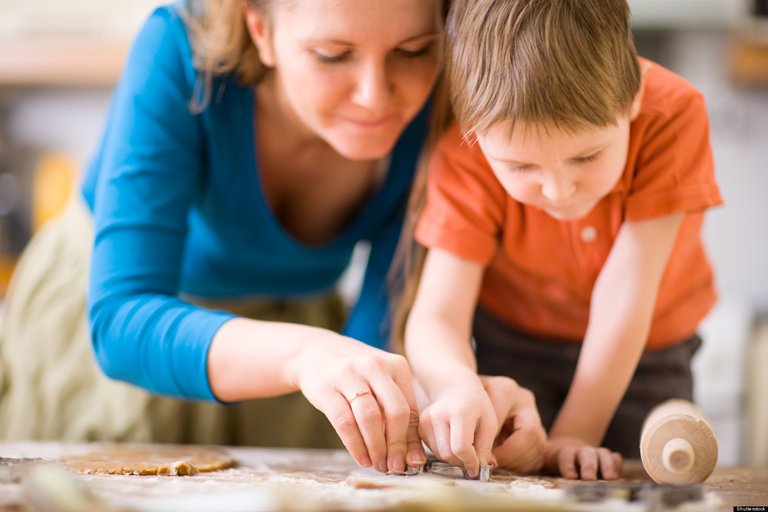OK. So, Smartmom knows what a bad mom is. And if she wants to know more, she just has to read one of those hip new bad parenting books she was talking about last week.
But what’s a good mom? Smartmom certainly knows plenty of them. Or so she thinks. But what are the common qualities that define them? Is there just one way to be? Is it like the first line from “Anna Karenina”: “Happy families are all alike; every unhappy family is unhappy in its own way.”
Smartmom doesn’t think so. Good parenting like bad parenting is not a cookie-cutter thing. Not all bad parents are bad in the same way. Likewise, not all good parents are alike. There are so many flavors and styles; so many ways to be.
But there must be some basics that insure entry into the Good Mothers Club. For starters, you’ve got to have the “food, clothing and shelter” part down pat, and it helps to have a real handle on health, education and welfare part, too.
Sure, those are the minimum daily requirements. But there are other things, too: Intangibles. Special somethings. That je ne sais quois that separates the good from the bad. Good mothering like bad mothering is something that happens behind closed doors. There are plenty of bad parents who do everything right on the outside, but don’t get the emotional piece. By the same token, there are plenty of good mothers, whose lives look like train wrecks.
So what’s a good mom?
Buddha knows, psychologists have been grappling with that question for decades. Freud had his ideas about what constituted good parenting. So did psychologist Donald Winnicott, who wrote about the “good-enough mother,” the one who takes the time to carefully witness (and mirror) her child’s play. And don’t forget Dr. William Sears, the parenting expert, who coined the phrase “attachment parenting,” a theory that emphasizes the importance of a child’s emotional bond with parents during babyhood. According to Sears, secure attachment insures fulfilling relationships in adulthood.
In other words: watch out moms: those first few years are a make or break time for your kid’s emotional life. And that’s a lot of pressure for anyone, especially a postpartum woman.
In 1997, the year that the Oh So Feisty One was born, the work of Dr. Sears was very much in vogue. For Smartmom, it felt like a non-stop race to make it in the attachment sweepstakes. This was five years after Teen Spirit’s birth, and it felt like a different era in terms of parenting styles. There was pressure to breast-feed 24-7. There were moms who thought that if they didn’t carry their kid around in one of those weird sling things, their child would be psychologically damaged. And those slings were so complicated that Boing Boing offered special workshops to teach parents how to use them so that they could wear their babies like a baby kangaroo.
Smartmom pushed OSFO around in a Maclaren stroller and worried that she wasn’t being nurturing enough.
As OSFO grew from newborn to toddler, Smartmom felt pressure to play with her as much as possible. Even when Smartmom was bone tired and wanted to nap, even when a really great issue of the New Yorker beckoned.
Smartmom pushed herself to be the kind of mom who played with Teletubbies on the floor or made make-believe breakfast at the make-believe stove.
Now don’t get her wrong. Smartmom LOVED being around OSFO, who was as adorable and feisty then as she is now. That’s not the point. It’s just all this pressure to be a good mom was really getting her. And making her wonder if she was any good at all.
And many of Smartmom’s friends felt the same way. Some worried incessantly whether they were “good enough” moms. Her mother’s group was sometimes a “Can You Top This” about how much time the moms were spending with their kids and all the educationally fortifying activities they were doing like Mommy and Me, Gymboree, Music Together, Music for Aardvarks, gymnastics and even cooking for 1-year-olds.
The mommy group would sometimes reduce Smartmom to feelings of inadequacy. She remembers being jealous of one mom who made her own baby food; the one who was teaching her child sign language; and another one who was still breast-feeding past the 18-month mark. These were the signposts that Smartmom measured herself by.
And she often fell short.
At home, Smartmom felt guilty when she wanted to check her e-mail or do some writing in the dining room. But OSFO took care of that. She learned early on how to turn the computer off. Smartmom discovered that in order to get some writing done, she could put OSFO in the kitchen sink, where she loved to play with small plastic bowls in the bubble bath.
And that’s when Smartmom had a revelation. She realized that she and OSFO could do parallel play, that much-used phrase from developmental psychology. They didn’t need to be joined at the hip all the time. Smartmom could work on a short story, while OSFO engaged in water play (while Smartmom supervised from a few feet away, of course). Smartmom would check in on her little dumpling and splash her with some soapy water and then get back to what she was doing on the computer.
Bingo. They were both happy.
Soon Smartmom was less hard on herself about attachment parenting and quality time. Some days she would devote to playground play, trips to the zoo or the children’s museum. Other days, Smartmom needed to work, see friends, or take care of errands. Just like the baby, she had needs, too.
Slowly, Smartmom realized that good mothering had less to with whatever the experts were saying and more to do with what works for you and your child. For some moms, it’s about wearing a sling. For others, it’s baking cookies, reading every volume of “A Series of Unfortunate Events” out loud to their children, or being creative with watercolors and modeling clay. Still others just want to hang out in the apartment and do things side by side.
In the final analysis, good mothering is about loving your children, talking to them and listening to what they have to say. It’s also about teaching them to be happy, creative people who care about others and are in tune with themselves. Perhaps most importantly, it’s about figuring out what works for you and not focusing too much on the way other people live their lives.
Now, at age 12, OSFO is too big for the kitchen sink now. But she and Smartmom do spend an inordinate amount of time in the same room engaged in parallel play: reading, working on the computer, watching TV. Sometimes they even talk. And sometimes, when Smartmom is very lucky, they even hug.
And Smartmom likes those times best of all
Source
Plagiarism is the copying & pasting of others work without giving credit to the original author or artist. Plagiarized posts are considered spam.
Spam is discouraged by the community, and may result in action from the cheetah bot.
More information and tips on sharing content.
If you believe this comment is in error, please contact us in #disputes on Discord
Hi! I am a robot. I just upvoted you! I found similar content that readers might be interested in:
https://www.brooklynpaper.com/stories/32/17/32_17_sm_smartmom.html
Hello @djrahul! This is a friendly reminder that you have 3000 Partiko Points unclaimed in your Partiko account!
Partiko is a fast and beautiful mobile app for Steem, and it’s the most popular Steem mobile app out there! Download Partiko using the link below and login using SteemConnect to claim your 3000 Partiko points! You can easily convert them into Steem token!
https://partiko.app/referral/partiko
Congratulations @djrahul! You received a personal award!
You can view your badges on your Steem Board and compare to others on the Steem Ranking
Vote for @Steemitboard as a witness to get one more award and increased upvotes!